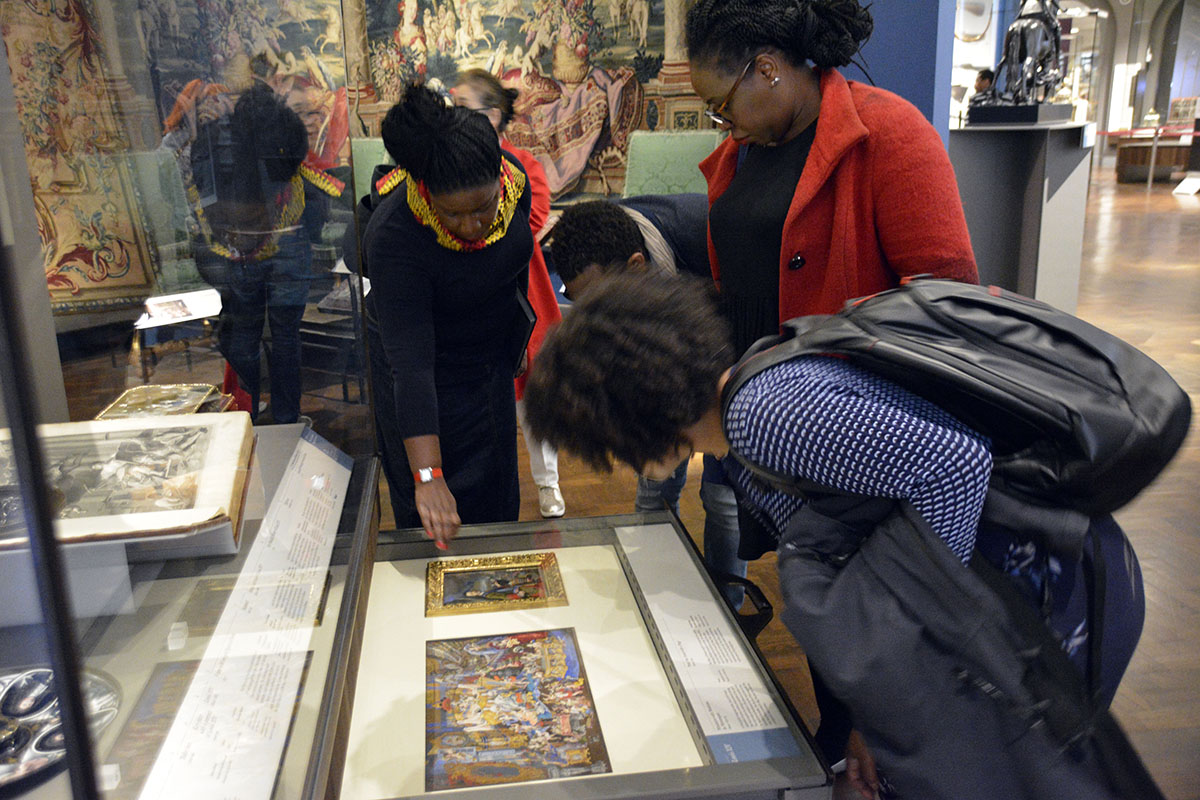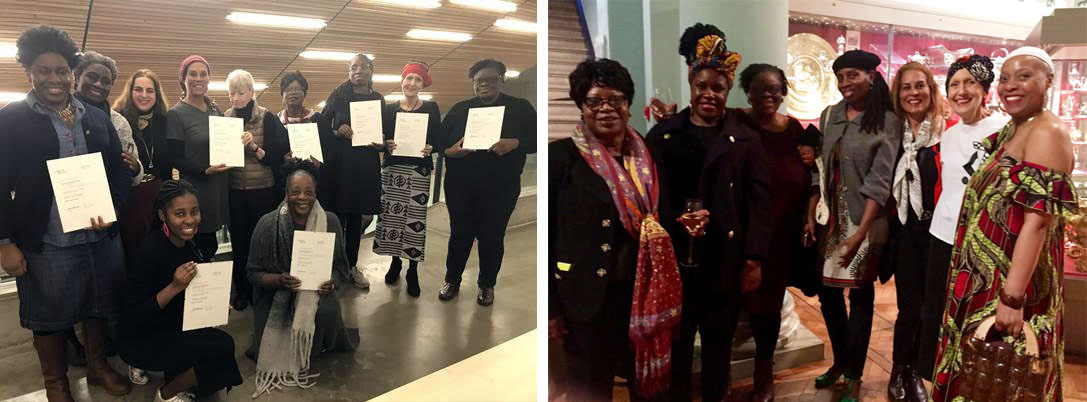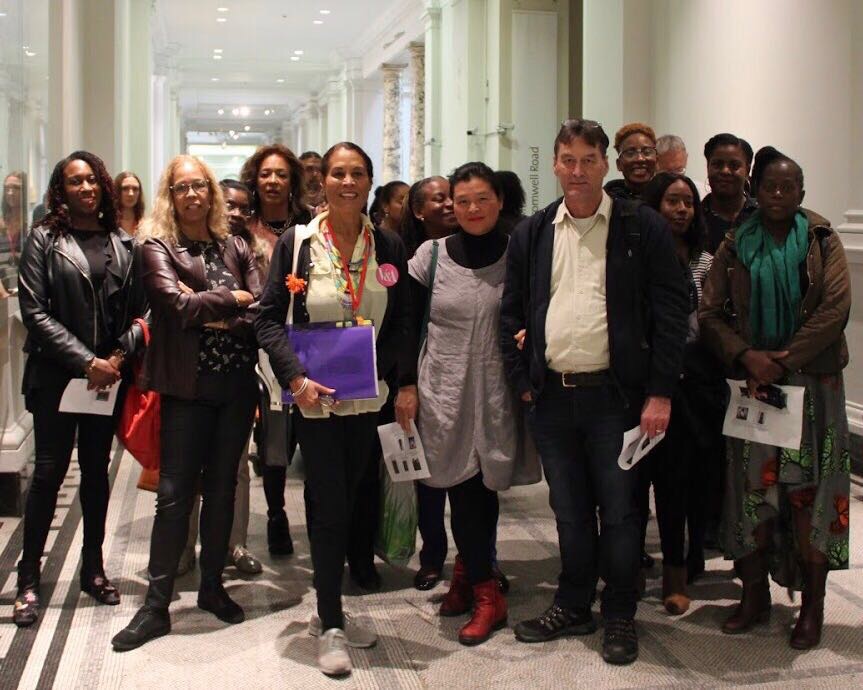2021 marks five years of the African Heritage (AH) Guides at the V&A. In this post my fellow guides and I alongside Janet Browne – who shaped the programme from its inception – share our reflections and our hopes for the future.
Janet Browne, Senior Producer – Audience Development (V&A Academy)
January 2016 witnessed the creation of the first ever UK Museum led training of African Heritage guides. Who knew it would be an all female cast – not by design? ‘Am I not a woman, a sister and a mother’, are my words of homage to these ten sharp-witted heroines who highlight the important contributions made by Black people throughout centuries across our collections. As the designer of the training programme, to me it was imperative that the Guides challenged previous forms of ‘storytelling’ as reparative action, be at the forefront of change, and influence post-colonial thinking and interpretation of Black narratives within Western museum practice. They committed to a three-year relationship with the V&A; agreed to be self-reflective while demonstrating a passion for learning, research and development; to decolonise and amplify many narratives within the galleries; to become active ambassadors embracing V&A values of collaboration, integrity and generosity, and to use their new knowledge and experience to grow and welcome a multicultural audience. They had to feel safe and equipped to lead and engage with often sensitive and complex histories. In 2019 the African Heritage Guides were Highly Commended in the Marsh Award for Volunteers in Museum Learning.

Joy Johnson
The African Heritage Guide team at the V&A has developed into a rich nucleus for shared learning and enhanced my personal development. However, one of my most cherished memories was the reactions I experienced on my very first ‘Historical & Hidden Caribbean’ tour on a Sunday afternoon. I was truly surprised at how hungry the visitors were for knowledge about the objects shown during a three century, intertwined narrative of British and Caribbean stories. It was heartening to see so many people attend, bringing along relatives who were often second or third generation Black British born. I distinctly remember one lady from the USA with her granddaughter at the end of the tour remarking in a barely audible whisper ‘wishing she had the opportunity to attend tours like this’ when she was a schoolgirl growing up in England decades ago. She was visibly excited when I spoke about Carnival and its legacy in British culture. It made me feel quite emotive that the knowledge we were sharing at the V&A was being appreciated and that I was part of the team of guides delivering it!
Kim Sheldon
These past years as an African and Caribbean Heritage Guide at the V&A have been a wonderful experience. A memorable moment for me personally was right at the beginning, as I waited nervously at the meeting point to take my first tours, hoping I could remember the amazing information I had to share. As I waited, I noticed the enormous main entrance was becoming a sea of black and brown faces and they were being directed towards me. It was a special feeling, to see people who wanted to know more about objects within the museum that they could connect to. Throughout the tour people were engaged and engaging. I knew then I would be doing these tours for a long time.
It was great and enlightening! I will certainly recommend the visit to others
Excellent, very well conducted tour. The guide made the tour more interesting and relevant with her encyclopaedic knowledge of the subject
Visitor feedback
Avril Horsford
I have worked with Janet Browne for many years, and my previous ‘Hidden Caribbean’ tours had been a flexible addition to the wide variety of issues explored within the subject of Black history and heritage; and the role the V&A occupied as a channel of enquiry and interpretation. Since joining the broadened remit through the introduction of the African Heritage Guides, I have found a natural place of belonging, in a setting within which many of us would not automatically have felt comfortable in the not-too-distant-past. The guides caused a notable stir within the Museum, on many levels, but it was the emotional impact of our presence on the new Black audience our introduction aimed to encourage that will remain with me forever. Many visitors remained after the tours to thank us for our very presence expressing their pride at, ‘seeing Black people in this position’, often expressed through tears. Memorably, some visitors came, and although standing closely beside me, said absolutely nothing; but their silence contained shared emotions that might otherwise deafen within our unspoken exchange. I believe I have learned more from those on my tours than they have learned from me.

Margaret Raffin
It has been a pleasure and privilege to present African Heritage (AH) tours, in the Europe 1600 – 1815 Galleries. The moment that has stayed with me throughout is the sight of hundreds of people pouring into the museum for the first of these tours. I realised there was a need to show the AH related objects to the public in an interesting way, that there was a huge appetite for learning and that I would be sharing information with an appreciative audience. This is a responsibility that has led to me as a guide endeavouring to keep up to date with not only the historical context of objects, but to keep abreast of new research. The way in which AH Guides have shared information, news of new books, exhibitions and contemporary theatre and art has helped to foster a tight-knit and supportive group.
Donata Miller
I visited the museum in 2015 for a workshop on Caribbean national dress, focusing on textiles such as madras and bandana. As a history student, I enjoyed speaking about African and Caribbean heritage, and was pleased to find out that applications would open for an inaugural group of African Heritage Tour Guides later in the year. I began to give African Heritage tours at the V&A in 2016, and have not looked back since! The tours are more than just a weekend activity, instead they offer a space to connect, grow and reflect on European history. Throughout my tour I embark on a journey with participants; rooted in the 17th, 18th and 19th centuries but speaking to the power, presence, and prestige of Black people across the ages. Often, I find that the tours offer a form of therapy, an opportunity to be heard where previously ignored – and to uncover histories that are usually given less visibility. I am part of a wider guiding community, and have received invaluable support, care and precious memories as we have grown together over the last five years. As Maya Angelou once said, ‘If you are always trying to be normal, you will never know how amazing you can be.’ I am so grateful to Janet Browne and the other guides for creating the environment where we draw the amazing out of each other.
Nadia Denton
In relation to what moment of my African Heritage guide journey I reflect on the most, there are two things. One, guiding groups where there was a clear variation in historical and political awareness among attendees, but being able to successfully bring these individuals on a journey of shared knowledge. Beyond the practical satisfaction, it has shown me how the tours serve to remind us all about our collective humanity. Two, my interpretation of the lives of the individuals (depicted in objects) I have talked about as part of the tour. I have often wondered what would they have thought about my interpretation of their history, and whether my analysis did them justice? What would they think if they were stood in the audience?
Nkechi Noel
My long-lasting highlights have been the training sessions and my first tour, for me they are interconnected, as they heralded the start of my journey as an African Heritage Guide. During my training I went through a gamut of emotions, as I had started to feel a deep connection with the objects. Most of the objects we delved into in the European galleries are of unknown people of African descent, so I felt a big sense of responsibility to honour and to pay my respects to the objects. They were not directly family, but perhaps they could have been my ancestors, my lost kin with stories left untold. The sessions, the group interaction and my research led me to delve back in time and engage with the richness of African Heritage. I drew strength from the stories and journeys. They were part of my journey now; I was not to be the same, I was on a voyage of personal reclamation. For me I will never forget my first tour, as it was the first time I heard stories about the objects from visitors too. This always touches me, and inspires me to dig deeper; to look for more stories of people of African descent. Ashe, Ashe.
This has given me the chance to explore other areas of the museum that have artefacts connected to African and African Caribbean heritage
I was affected both intellectually and emotionally by the information and will read more about the artefacts
Visitor feedback
Pennie Mendes
Firstly, ‘Thank you’ Janet Browne so much for all your hard work to bring the African Heritage and Historical Caribbean tours onto the V&A’s guiding programme. Secondly, my own personal experience has been the joy of incredible interactive collaboration with my fellow African Heritage Guides. Their support, generosity in sharing knowledge and humour has allowed me to grow in confidence in giving talks to visitors. Thirdly, what also has been so wonderful for me, is to interact with the enthusiastic visitors, who on many occasions have also shared their knowledge with me. This has all been a truly inspirational and wonderful journey. Here’s to doing many more tours and learning even more, especially if the V&A acquires new acquisitions from Africa and the Caribbean.
Stella Kemi Akintan
Being an African Heritage Guide is both a privilege and responsibility. I relish the opportunity to talk about the beauty and craftsmanship of the objects. Every piece has a story, and this role fits perfectly with my passion for learning and sharing Black history. In the early days, the tours were met with large crowds, predominantly from the Black community, keen to see themselves reflected in the museum. Hence, we all felt a great sense of responsibility to do our best draw out the history and re-balance the narrative that makes some groups feel invisible. The European Galleries in all their splendour was a great place to make this happen, where we were able to share about the African presence from the 22 objects on display. As guides we all have the passion to provide this information to the best of our ability and regularly work together to build our knowledge base. Black Lives Matter has brought the issues of the importance of Black history as a mainstream subject to the fore – and the museum has renewed its commitment to this agenda. I am very optimistic that things are moving in the right direction.
Janet Browne, Senior Producer – Audience Development (V&A Academy)
Five years on, this sisterhood continues, and their progress has not gone unnoticed, including for the first time a Black vice chairperson on the Guides Committee; widening their repertoire and working on alternative projects outside of their African Heritage brief, namely the Fashion in Focus and Dementia tours respectively, and most recently the talks to celebrate the re-opening of the Raphael Gallery. In addition to growing a fruitful collaboration with the V&A Research Institute (VARI), they began their own forum during the pandemic, a virtual meet-up of kinship and support, and a transformative space for appraising new narratives, sharing and presenting material including those from international artists, curators and historians. The Guides paid their tribute to George Floyd and the outpouring for BLM through the rich contributions they made to the V&A visitor trails ‘Africans in Europe’ and ‘Britain and the Caribbean’. It is exciting for me to observe the Guides’ continued energy, their determined restlessness and unwavering pursuit for knowledge. They represent the voices of the disenfranchised and the underrepresented who, in the past, had no opportunity to speak their truth . They work towards raising the collective consciousness of our visitors, so they too can acknowledge the power of the messages within the collections as a tool for mental healing, and a reminder that this is our birthright to the future.

I have attended the African Heritage tours many times, and I would not have been aware of the narratives and history relating to the artefacts if there was not an African Heritage tour
Visitor feedback
Sheba Montserrat
In keeping with the talking shops of the 18th-century French salons where the thinkers of the day gathered to philosophise on life, my tour contains a debate when we reach the globe.
We sit in the seated sphere where I prompt the visitors to exchange views on the use (and misuse) of language around the transatlantic slave trade that unconsciously serves to uphold the mindset of white supremacy. This particular Friday in March 2016, we had an unusually high attendance. I counted 75 people; it could’ve been more or less, but not by much either way.
I stood in the centre and was being filmed from all angles. The crowd were all ages, all of colour and the atmosphere was pleasantly charged. I wanted to bring light to the term ‘They took slaves out of Africa’.
‘When you say ‘they’, who are you talking about. Who are ‘they’?’ Asked a young king in his mid 30s and full of debate enthusiasm. His challenge made me restructure the sentence.
‘Okay. It’s commonly said that slaves were taken from Africa. What’s wrong with that sentence?’ This time his bredrin responded.
‘We’re not here to talk about Africans selling Africans, save that for another day.’ They were inspired to display their knowledge.
‘No that’s not what I’m alluding to,’ I said. And asked the question again.
As she ruffled open her boiled sweet an elder spoke. ‘Dem nevva tek no slave outta Africa.’ She said with a lyrical Caribbean accent. ‘It’s people dem tek!’
I pointed and held the gesture.
‘Exactly!’
There was a silent tingle to the ambiance as 75 people reacted to the missed simplicity of the answer. We immediately continued on to the next artefact.
It was a lovely ‘each one teach one’ moment.
My fellow African Heritage Guides and I would like to thank Janet Browne for her unwavering support and guidance over the last five years, Caterina Bisquert, Senior Volunteer Manager, for her empathy and can-do approach and also our mentors Elizabeth Hamilton, Colin Lomas and Margaret Raffin for their patience and generosity in sharing their experience as Guides.
If we stand tall it’s because we stand on the shoulders of our ancestors – African proverb


